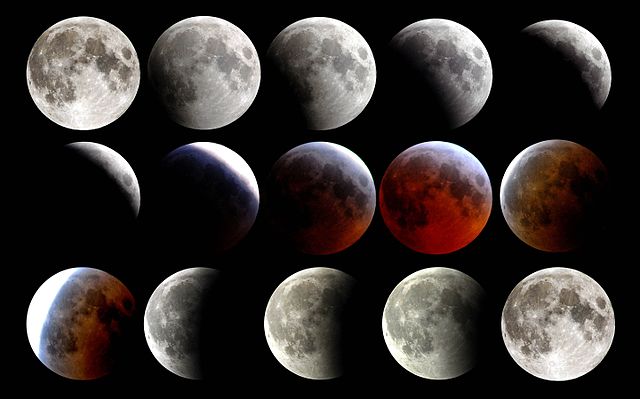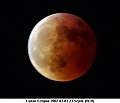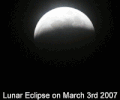Lunar eclipses
The previous lunar eclipse on 7 September 2006 was partial.
This eclipse is the first of two lunar eclipses to occur in 2007, the second being on 28 August 2007. The tables below contain detailed predictions and additional information on the Total Lunar Eclipse of 3 March 2007.
Penumbral Magnitude = 2.31882
Umbral Magnitude = 1.23280
Gamma = 0.31749
Greatest Eclipse = 03 Mar 2007 23:20:53.5 UTC (23:21:58.7 TD)
Sun right ascension = 22 hours, 57 minutes, 19.2 seconds
Sun declination = 6 degrees, 40 minutes, 46.3 seconds south of Celestial Equator
Sun diameter = 1936.0 arcseconds
Moon right ascension = 10 hours, 57 minutes, 52.2 seconds
Moon declination = 6 degrees, 56 minutes, 0.7 seconds north of Celestial Equator
Moon diameter = 1782.6 arcseconds
Earth's shadow right ascension = 10 hours, 57 minutes, 19.2 seconds
Earth's shadow declination = 6 degrees, 40 minutes, 46.3 seconds north of Celestial Equator
Totality duration = 1 hour, 13 minutes, 21.3 seconds
Umbral duration = 3 hours, 41 minutes, 5.6 seconds
Total duration = 6 hours, 5 minutes, 31.3 seconds
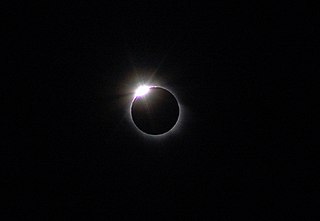
A total solar eclipse occurred on March 29, 2006. A solar eclipse occurs when the Moon passes between Earth and the Sun, thereby totally or partly obscuring the image of the Sun for a viewer on Earth. A total solar eclipse occurs when the Moon's apparent diameter is larger than the Sun's, blocking all direct sunlight, turning day into darkness. Totality occurs in a narrow path across Earth's surface, with the partial solar eclipse visible over a surrounding region thousands of kilometres wide. It was visible from a narrow corridor which traversed half the Earth. The magnitude, that is, the ratio between the apparent sizes of the Moon and that of the Sun, was 1.052, and it was part of Saros 139.

A total lunar eclipse occurred on February 20 and February 21, 2008. It was visible in the eastern evening sky on February 20 for all of North and South America, and on February 21 in the predawn western sky from most of Africa and Europe. Greatest Eclipse occurring on Thursday, February 21, 2008, at 03:26:03 UTC, totality lasting 49 minutes and 45.6 seconds.

A total lunar eclipse took place at the Moon's descending node of the orbit on Tuesday, September 16, 1997, the second of two lunar eclipses in 1997. A shallow total eclipse saw the Moon in relative darkness for 1 hour, 1 minute and 30.8 seconds. The Moon was 19.094% of its diameter into the Earth's umbral shadow, and should have been significantly darkened. The partial eclipse lasted for 3 hours, 16 minutes and 28.2 seconds in total. The penumbral eclipse lasted for 5 hours, 8 minutes and 20.1 seconds. The partial eclipse lasted for 3 hours, 16 minutes and 28.2 seconds. The total eclipse lasted for 1 hour, 1 minute and 30.8 seconds. Maximum eclipse was at 18:46:39.1 UTC. The moon's apparent diameter was extremely large because occurred only 3 hours and 21 minutes past perigee. The Moon was only 356,986 km of the Earth at greatest eclipse.

A total lunar eclipse will take place on July 7, 2047. It will last 1 hour 40 minutes and 49 seconds and will plunge the full Moon into deep darkness, as it passes right through the centre of the Earth's umbral shadow. While the visual effect of a total eclipse is variable, the Moon may be stained a deep orange or red colour at maximum eclipse. This will be a great spectacle for everyone who sees it. The partial eclipse will last for 3 hours and 39 minutes in total.
A partial lunar eclipse took place on Saturday, June 25, 1983, the first of two lunar eclipses in 1983 with an umbral eclipse magnitude of 0.33479. A partial lunar eclipse happens when the Earth moves between the Sun and the Full Moon, but they are not precisely aligned. Only part of the Moon's visible surface moves into the dark part of the Earth's shadow. A partial lunar eclipse occurs when the Earth moves between the Sun and Moon but the three celestial bodies do not form a straight line in space. When that happens, a small part of the Moon's surface is covered by the darkest, central part of the Earth's shadow, called the umbra. The rest of the Moon is covered by the outer part of the Earth's shadow called the penumbra. The Earth's shadow on the moon was clearly visible in this eclipse, with 33% of the Moon in shadow; the partial eclipse lasted for 2 hours and 15 minutes.
A penumbral lunar eclipse took place on Thursday, March 3, 1988, the first of two lunar eclipses in 1988, the second being on August 27, 1988. Earlier sources compute this as a 0.3% partial eclipse lasting under 14 minutes, and newest calculations list it as a penumbral eclipse that never enters the umbral shadow. In a rare total penumbral eclipse, the entire Moon was partially shaded by the Earth, and the shading across the Moon should have been quite visible at maximum eclipse. The penumbral phase lasted for 4 hours, 53 minutes and 50.6 seconds in all, though for most of it, the eclipse was extremely difficult or impossible to see. The Moon was 2.2 days after apogee, making it 6.1% smaller than average.
A penumbral lunar eclipse took place on Tuesday, January 20, 1981, the first of two lunar eclipses in 1981. In a rare total penumbral eclipse, the entire Moon was partially shaded by the Earth, and the shading across the Moon should have been quite visible at maximum eclipse. The penumbral phase lasted for 4 hours and 24 minutes in all, though for most of it, the eclipse was extremely difficult or impossible to see. The moon's apparent diameter was larger because the eclipse occurred 5.2 days after perigee.
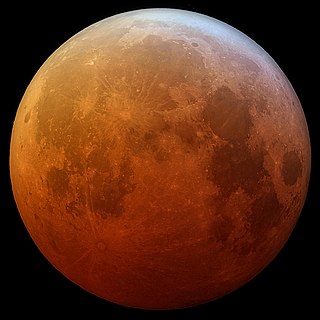
A total lunar eclipse occurred on 21 January 2019 UTC. For observers in the Americas, the eclipse took place between the evening of Sunday, 20 January and the early morning hours of Monday, 21 January. For observers in Europe and Africa, the eclipse occurred during the morning of 21 January. The Moon was near its perigee on 21 January and as such can be described as a "supermoon".

A total lunar eclipse took place on Saturday, April 13, 1968, the first of two total eclipses in 1968, the second being on October 6, 1968.
A partial lunar eclipse took place on Monday, August 17, 1970, the second of two lunar eclipses in 1970, the first was on February 21 of that year. The Earth's shadow on the Moon was clearly visible in this eclipse, with 41% of the Moon in shadow; the partial eclipse lasted for 2 hours and 11 minutes. It was the second of two lunar eclipses in 1970.

A total lunar eclipse took place on Monday, April 24, 1967, the first of two total lunar eclipses in 1967, the second being on October 18, 1967.
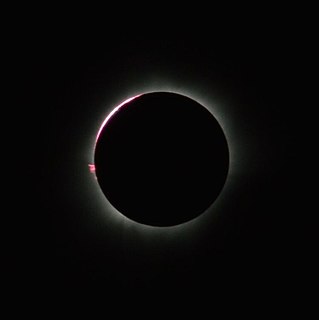
A total solar eclipse took place at the Moon's descending node of the orbit on March 8–9, 2016. If viewed from east of the International Date Line, the eclipse took place on March 8 (Tuesday) and elsewhere on March 9 (Wednesday). A total solar eclipse occurs when the Moon's apparent diameter is larger than the Sun's and the apparent path of the Sun and Moon intersect, blocking all direct sunlight and turning daylight into darkness; the sun appears to be black with a halo around it. Totality occurs in a narrow path across Earth's surface, with the partial solar eclipse visible over a surrounding region thousands of kilometres wide. The eclipse of March 8–9, 2016 had a magnitude of 1.0450 visible across an area of Pacific Ocean, which started in the Indian Ocean, and ended in the northern Pacific Ocean.

An annular solar eclipse occurred at the Moon's ascending node of the orbit on January 15, 2010, with a magnitude of 0.91903. A solar eclipse occurs when the Moon passes between Earth and the Sun, thereby totally or partly obscuring the image of the Sun for a viewer on Earth. An annular solar eclipse occurs when the Moon's apparent diameter is smaller than the Sun's, blocking most of the Sun's light and causing the Sun to look like an annulus (ring). An annular eclipse appears as a partial eclipse over a region of the Earth thousands of kilometres wide. It was the longest annular solar eclipse of the millennium, and the longest until December 23, 3043, with the length of maximum eclipse of 11 minutes, 7.8 seconds, and the longest duration of 11 minutes, 10.7 seconds. This is about 4 minutes longer than total solar eclipses could ever get.
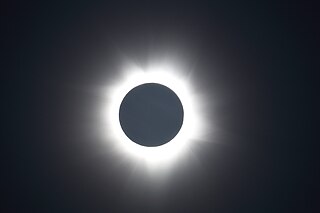
A total solar eclipse took place on 13–14 November 2012 (UTC). Because it crossed the International Date Line it began in local time on November 14 west of the date line over northern Australia, and ended in local time on November 13 east of the date line near the west coast of South America. Its greatest magnitude was 1.0500, occurring only 12 hours before perigee, with greatest eclipse totality lasting just over four minutes. A solar eclipse occurs when the Moon passes between Earth and the Sun, thereby totally or partly obscuring the image of the Sun for a viewer on Earth. A total solar eclipse occurs when the Moon's apparent diameter is larger than the Sun's, blocking all direct sunlight, turning day into darkness. Totality occurs in a narrow path across Earth's surface, with the partial solar eclipse visible over a surrounding region thousands of kilometres wide.

An annular solar eclipse occurred on December 14, 1955. A solar eclipse occurs when the Moon passes between Earth and the Sun, thereby totally or partly obscuring the image of the Sun for a viewer on Earth. An annular solar eclipse occurs when the Moon's apparent diameter is smaller than the Sun's, blocking most of the Sun's light and causing the Sun to look like an annulus (ring). An annular eclipse appears as a partial eclipse over a region of the Earth thousands of kilometres wide.

An annular solar eclipse occurred at the Moon's descending node of the orbit on February 4–5, 1981. A solar eclipse occurs when the Moon passes between Earth and the Sun, thereby totally or partly obscuring the image of the Sun for a viewer on Earth. An annular solar eclipse occurs when the Moon's apparent diameter is smaller than the Sun's, blocking most of the Sun's light and causing the Sun to look like an annulus (ring). An annular eclipse appears as a partial eclipse over a region of the Earth thousands of kilometres wide. This annular solar eclipse was large because the Moon covered 99.4% of the Sun, with a path width of only 25 km . It was visible in Australia, crossing over Tasmania and southern Stewart Island of New Zealand near sunrise on February 5 (Thursday), and ended at sunset over western South America on February 4 (Wednesday). Occurring only 4 days before perigee, the moon's apparent diameter was larger.

A total solar eclipse occurred on June 8–9, 1956. A solar eclipse occurs when the Moon passes between Earth and the Sun, thereby totally or partly obscuring the image of the Sun for a viewer on Earth. A total solar eclipse occurs when the Moon's apparent diameter is larger than the Sun's, blocking all direct sunlight, turning day into darkness. Totality occurs in a narrow path across Earth's surface, with the partial solar eclipse visible over a surrounding region thousands of kilometres wide. It began near sunrise over New Zealand on June 9 (Saturday), and ended west of South America on June 8 (Friday).

A total solar eclipse will occur on Monday, May 1, 2079, with a maximum eclipse at 10:48:25.6 UTC. A solar eclipse occurs when the Moon passes between Earth and the Sun, thereby totally or partly obscuring the image of the Sun for a viewer on Earth. A total solar eclipse occurs when the Moon's apparent diameter is larger than the Sun's, blocking all direct sunlight, turning day into darkness. Totality occurs in a narrow path across Earth's surface, with the partial solar eclipse visible over a surrounding region thousands of kilometres wide. The eclipse will be visible in Greenland, parts of eastern Canada and parts of the northeastern United States.
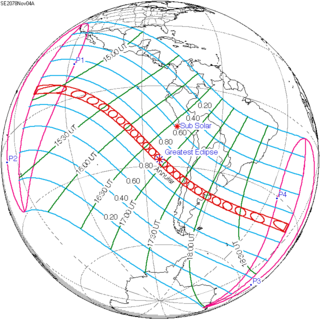
An annular solar eclipse will occur on Friday, November 4, 2078. A solar eclipse occurs when the Moon passes between Earth and the Sun, thereby totally or partly obscuring the image of the Sun for a viewer on Earth. An annular solar eclipse occurs when the Moon's apparent diameter is smaller than the Sun's, blocking most of the Sun's light and causing the Sun to look like an annulus (ring). An annular eclipse appears as a partial eclipse over a region of the Earth thousands of kilometres wide. The path of annularity will cross Pacific Ocean, South America, and Atlantic Ocean. The tables below contain detailed predictions and additional information on the Annular Solar Eclipse of 4 November 2078.

A total lunar eclipse will occur on Wednesday, June 9, 2123, with maximum eclipse at 05:06 UTC. A dramatic total eclipse lasting 106 minutes and 6 seconds will plunge the full Moon into deep darkness, as it passes right through the centre of the Earth's umbral shadow. While the visual effect of a total eclipse is variable, the Moon may be stained a deep orange or red colour at maximum eclipse. This will be a great spectacle for everyone who sees it. The partial eclipse will last for 3 hours and 56 minutes in total. The penumbral eclipse lasts for 6 hours and 14 minutes. Maximum eclipse is at 05:06:28 UT. This will be the longest Total Lunar Eclipse since 16 July 2000, and the longest one until 12 May 2264 and 27 July 3107, though the eclipse on June 19, 2141 will be nearly identical in all aspects. This will also be the longest of the 22nd century and the second longest of the 3rd millennium. The eclipse on June 19, 2141 will be the second longest of the 22nd century and the third longest of the third millennium.






































